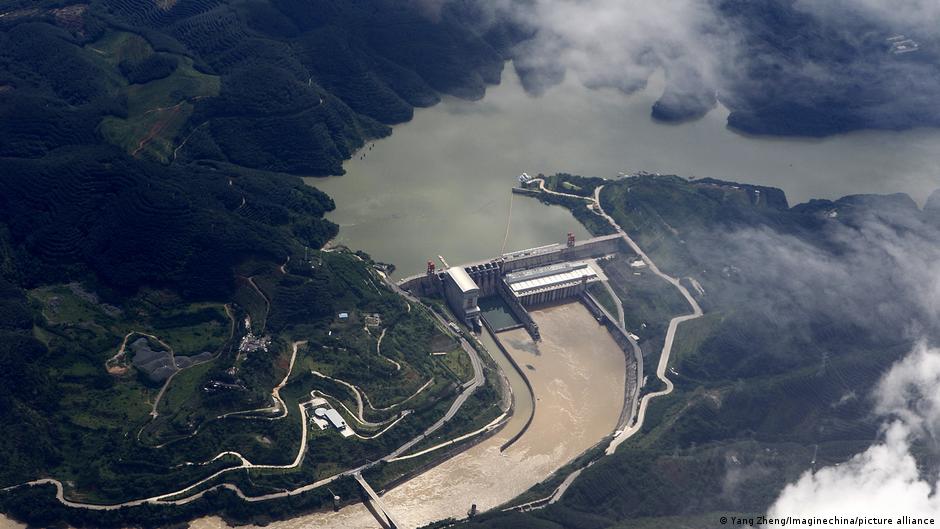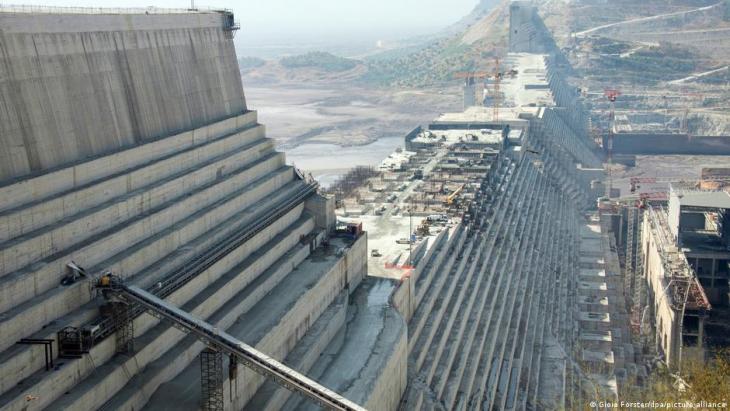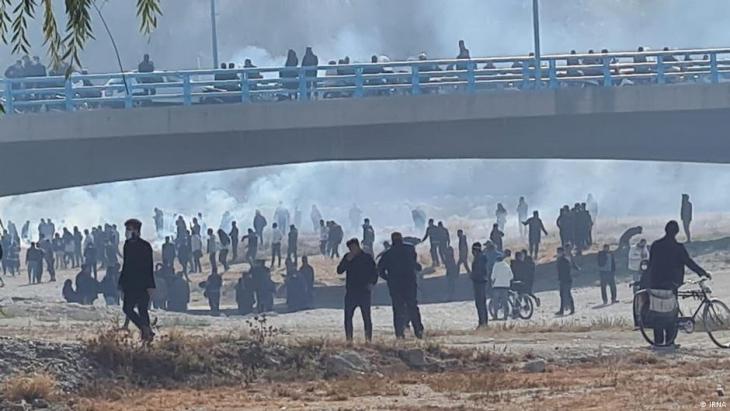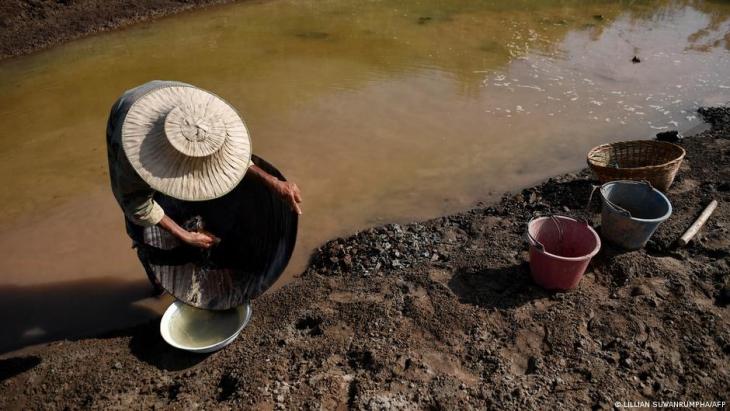Water resources – another conflict trigger?

Early on in Russia's invasion of Ukraine, Moscow announced it had bombed a dam on the North Crimean Canal. After Russia annexed Crimea in 2014, Ukraine erected the dam, blocking a vital water supply to the occupied territory and resulting in severe water shortages.
The war in Ukraine is not being fought over Crimea's water supply. But the Pacific Institute's Water Conflict Chronology details examples of water as a weapon, casuality or trigger of conflict going back millennia. Ashok Swain, professor of peace and conflict at Uppsala University in Sweden and former UNESCO chair for international water co-operation, says Crimea's water supply is another example of this.
Yet shared water resources can also be an opportunity for co-operation. Even in Crimea, had the international community engaged Russia and Ukraine on how to solve the humanitarian issue of water, it might have "given them a possibility or a forum to negotiate, to discuss how to address this issue, and also solve other issues," says Ashok.
Water tensions
Some 40% of the global population lives on rivers that cross international borders. And with the climate crisis leaving more regions suffering from drought, how to share these essential resources equitably has raised high-profile tensions around the world.
In February, the Grand Ethiopian Renaissance Dam was finally switched on, despite ongoing objections from Egypt and Sudan, who have long feared the dam's impact on their farmlands further down the Nile.

Dams springing up along the Mekong River in China, meanwhile, have been blamed for drought in Thailand and Cambodia. And tensions between rivals India and Pakistan have been rising over their shared waters in the Indus River basin.
The Water Peace and Security online tool, built by partners including IHE Delft in the Netherlands and the World Resources Institute, shows a map of our planet peppered with tensions over water that threaten to turn violent. Yet, Scott Moore, author of "Subnational Hydropolitics: Conflict, Co-operation, and Institution-Building in Shared River Basins", says such unrest mainly happens within countries, rather than between them.
International tensions over water, Moore says, rarely escalate into full-blown conflict. And when disputes do flare, water is often a proxy for other issues.
"The intuition is that it's water that's the cause of tension and conflict, whereas I would say it's typically the reverse – where geopolitical tensions or economic disputes become translated into water," Moore says.
In the case of dams going up on the Mekong, for example, complex factors resulting in low water levels in downstream countries can be downplayed in the face of China's massive campaign on dam-building upstream. "There is increased anxiety among neighbouring countries about the consequences of China's growing power, and I think we see that reflected in water issues," Moore said.
Politics and drought in the Middle East
Water shortages in Iran have fuelled protests, dubbed the "Uprising of the Thirsty", since last summer. At the same time, tensions have flared in long-standing disputes with neighbouring Afghanistan over its Kamal Khan Dam upstream on the Helmand River.
Susanne Schmeier, associate professor of water law and diplomacy at IHE Delft, says blaming neighbouring countries for hoarding water can be a convenient diversion from domestic issues around water pricing and inefficient water infrastructure.

"Whenever Iran is facing strong domestic water crises, which would include protests by farmers or conflicts between urban citizens and farmers," Schmeier explains, "you also see at the same time, strong statements of Iranian policymakers towards Afghanistan saying, we want our fair share of the river."
And while Iran accuses its upstream neighbour of hoarding water, it is also building dams of its own – on the Helmand and other rivers, including a tributary of the Tigris that flows on into Iraq, which has water scarcity problems of its own.
Drought-stricken Iraq blames both Iran and Turkey for its water woes. Turkey has dams on both the Tigris and the Euphrates, and downstream, both Iraq and Syria say these dams are leaving them dry.
When it was built in the 1980s, Turkey agreed to release 500 cubic meters per second of Euphrates waters through the Ataturk hydropower dam to neighbouring Syria. Turkey is blaming climate change for the flow now falling well short of this. But Syrian Kurds across the border believe Turkey is punishing them as political rivals.
Swain says tensions over Ethiopia's GERD hydropower are also rooted in a tangle of geopolitical and climatic factors. The dam could, in theory, be mutually beneficial: downstream countries Egypt and Sudan could make use of its cheap electricity. At the same time, the dam could be used to regulate the Nile's flow to avoid the kind of flooding that has devastated areas of Sudan in recent years.
The question, however, is what might happen if a few successive dry years mean Ethiopia holds back water to keep its reservoir sufficiently full. "So that's why this kind of fear is coming in – it's climate change," Swain says.
Water as a "depoliticised" issue
International co-operation over Nile waters might be easier if upstream and downstream countries didn't fall on different sides of the geopolitical divide. "The world has divided into two camps... Ethiopia is getting support from China and Russia," Swain said, while Egypt and Sudan are more closely aligned with the West.

Yet Mehmet Altingoz, who researches transboundary management at the U.S. University of Delaware believes focusing on the humanitarian issue of Crimea's water supply could have helped diffuse tensions along precisely this global divide.
"NATO and the West missed an opportunity to ease tensions in the region by urging Ukraine to find a way to cooperate on providing water access to Crimea," argues an article he recently co-authored.
"It's easier to cooperate over environmental assets," he admitted. His own research has covered Turkey and Armenia, countries that have no diplomatic relations but share ownership of a Soviet-era dam that sits on their dividing border.
Every month, Altingoz explains, a technical committee comprising members of the rival nations meets to decide how water will be allocated: "There is extensive co-operation over this water body, and we realised it is improving relations locally."
Water for co-operation, not conflict
According to the UN, close to 300 international water treaties have been signed since 1948 and the vast majority rarely make headlines.
"There are far more instances and examples and cases of co-operation over water – especially if we define that in terms of international agreements dealing with the management of shared water resources – than there are instances or cases or examples of conflict," Moore said.
Though water tensions have regularly flared between India and Pakistan, the rival nations have worked together through the Indus Water Treaty, dating back to the 1960s, even as greater tensions ignited, Schmeier says: "India and Pakistan, even when they were at the brink of nuclear war, kept meeting under the treaty."
She also points to the stability pact that worked to build peace in the Balkans following war in the 1990s, taking the shared waters of the Danube as a starting point for co-operation.
"They negotiated an agreement, set up a river basin organisation and that brought the countries together and then that spilled over into also trade, into cleaning up remnants of war and all sorts of other things," Schmeier said.
Ruby Russell
© Deutsche Welle 2022